You're using an outdated browser. Please upgrade to a modern browser for the best experience.

Submitted Successfully!
Thank you for your contribution! You can also upload a video entry or images related to this topic.
For video creation, please contact our Academic Video Service.
| Version | Summary | Created by | Modification | Content Size | Created at | Operation |
|---|---|---|---|---|---|---|
| 1 | Albert Ayeni | + 2113 word(s) | 2113 | 2021-12-14 09:03:54 | | | |
| 2 | Vivi Li | Meta information modification | 2113 | 2022-01-28 07:11:51 | | |
Video Upload Options
We provide professional Academic Video Service to translate complex research into visually appealing presentations. Would you like to try it?
Cite
If you have any further questions, please contact Encyclopedia Editorial Office.
Ayeni, A. Micro/Baby-Greens and Mature Field Grown Vegetables. Encyclopedia. Available online: https://encyclopedia.pub/entry/18937 (accessed on 21 December 2025).
Ayeni A. Micro/Baby-Greens and Mature Field Grown Vegetables. Encyclopedia. Available at: https://encyclopedia.pub/entry/18937. Accessed December 21, 2025.
Ayeni, Albert. "Micro/Baby-Greens and Mature Field Grown Vegetables" Encyclopedia, https://encyclopedia.pub/entry/18937 (accessed December 21, 2025).
Ayeni, A. (2022, January 28). Micro/Baby-Greens and Mature Field Grown Vegetables. In Encyclopedia. https://encyclopedia.pub/entry/18937
Ayeni, Albert. "Micro/Baby-Greens and Mature Field Grown Vegetables." Encyclopedia. Web. 28 January, 2022.
Copy Citation
Micro/baby-greens are gaining popularity in human diets as functional foods that deliver superior nutritional values and health benefits to consumers. This study conducted multiple times between 2017 and 2019 under greenhouse conditions and in the field at Rutgers University, New Brunswick, New Jersey, USA, showed that micro/baby-greens from tropical spinach (Amaranthus sp.) and roselle (Hibiscus sabdariffa L.) are rich in digestible carbohydrates, digestible protein, and dietary fiber.
microgreens
baby greens
mature vegetables
nutritional elements
macronutrients
micronutrients
1. Introduction
Microgreens, also called “vegetable confetti” [1], belong to the group of plant foods classified as “functional foods” because they possess particular health promoting or disease preventing properties that are additional to their normal nutritional value [2] Morphologically, microgreens are plant seedlings that are between the cotyledonary and the first fully formed primary (true) leaf stages of growth [1]. Commercially and in culinary terms, they fall between the “sprout” and “baby green” vegetable packaging [3]. For plants with tiny seedlings, such as tropical spinach (Amaranthus spp.), the microgreen growth stage may be stretched a little longer than the first true leaf stage. While sprouts need water, air, and food reserves in the seed cotyledons (for dicot plants) or endosperm (for monocots) to germinate, emerge from the seed (or grain), and grow; in addition to these elements, microgreens need light for photosynthesis and nutrients from the growth media. Sprouts may be cultured exclusively in moist soilless media with or without light. However, microgreens rely on the food reserves in the sprout as well as nutrients in the growth media and light for photosynthesis to support the initial stages of metabolism needed to provide energy for subsequent vigorous growth of the microgreen, baby green, and the mature plant. The microgreens quite closely reflect the nutrient density of the sprout from which they are derived.
Microgreens are gradually gaining commercial attention globally as nutrient dense seedlings capable of supplying high nutritional and health values at relatively small consumption quantities compared to mature vegetables [3][4][5][6][7][8][9][10][11][12]. In the United States, interest in microgreens has increased 100% since 2004 [7] with Montana (#1–100%), Hawaii (#2–92%), and Vermont (#3–75%) topping the list of states with high interest in microgreens. On the same scale New Jersey (NJ) ranks #45 (of 50) with relatively low interest (32%) in microgreen production. It is desirable to add these nutrient dense plant sources to our food basket in NJ and elsewhere around the United States to promote the vitality of our workforce and enhance our agricultural economy.
The Ethnic Crops Research Program at Rutgers University is interested in documenting the nutritional value of top ethnic crops in its collection starting with tropical spinach (Amaranthus spp.) and roselle (Hibiscus sabdariffa L.) as micro/baby-greens and mature field grown vegetables. The objective was to determine the nutritional quality of micro/baby greens of tropical spinach and roselle compared with the mature field-grown plants. We compared the nutritional content of these crops, including digestible carbohydrates, digestible protein, total fat, dietary fiber, and elemental macro-and micro-nutrients as both greenhouse-cultured micro/baby-green and as mature field grown vegetables. In the greenhouse, microgreens were extended to the early baby-green stage to be able to track nutritional trends over 20 DAS, while the young seedling remained succulent. For this reason, the nomenclature “micro/baby-green” was used to describe the greenhouse-raised plant seedlings in this study.
2. Micro/Baby-Greens and Mature Field Grown Vegetables
Figure 1 shows the stages of growth at which the tropical spinach and roselle micro/baby-greens were sampled for analysis; and approximate growth status of the field grown tropical spinach and roselle at the times of sampling.
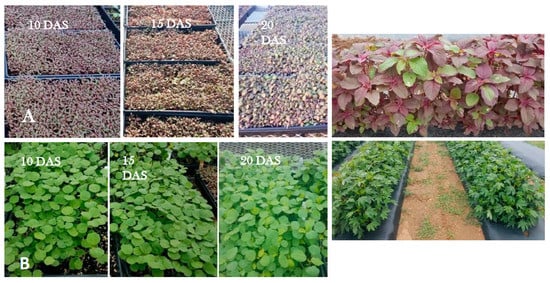
Figure 1. Micro/baby-greens of (A) tropical spinach, and (B) roselle at 10, 15, and 20 days after sowing (DAS); photos to the right show field grown tropical spinach (Caribbean red) (Top) and roselle (Indian Red-Red) (bottom) at the time of sampling for nutritional status determination. Photos by Albert Ayeni.
3. Growth Stage Impact on Nutritional Status
3.1. Tropical Spinach Micro/Baby-Green
Proximate analysis showed that both digestible carbohydrates and protein changed significantly in the tropical spinach micro/baby-green between 10 and 20 DAS. While the percent digestible carbohydrates doubled from 12.5% to 25% during the 10-day period between 10 and 20 DAS, the digestible protein decreased from 35% to 27% over the same period. The total fat and fiber percent did not change during this period (Figure 2). Elemental analysis showed that percent macronutrient content did not change except for K which dropped from approximately 7% to 6% during this 10-day period. However, the micronutrients Fe and Mn increased between 10 and 20 DAS in the tropical spinach micro/baby-green. The Fe level rose from 98 ppm to 175 ppm while Mn rose from 200 to nearly 300 ppm between 10 and 20 DAS. Copper remained very low (<2%) in the plant during this period while Zn, which was quite high (150–180 ppm), did not change significantly over the same period (Figure 2).
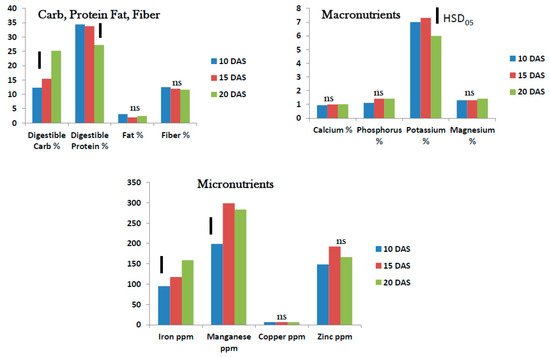
Figure 2. Tropical spinach micro/baby-green: nutrient status (dry weight basis) 10–20 days after seeding (DAS) (ns = no significant difference; bars show Tukey’s HSD at α = 0.05).
3.2. Mature (Field Grown) Tropical Spinach
The digestible carbohydrates and protein were about 25% in mature foliage of tropical spinach at 5 to 7 WAS. Fat was extremely low (<1%) and fiber ranged from 10–15%. In all cases, the growth stage did not impact the nutritional content of tropical spinach foliage significantly (Figure 3). Among the macronutrients analyzed, Ca (2.5–3%) and K (3.5–4.2%) were present at reasonably high levels. Phosphorus and Mg were present at <2% in the mature foliage. The stage of growth showed an impact only on Ca content which was significantly higher at 7 WAS than at 5 WAS. Among the micronutrients Fe content at 100–118 ppm was highest followed by Mn at 34–77 ppm. Copper was <5 ppm, while Zn was approximately 41 ppm in the mature foliage. Only Mn showed a higher level at 7 WAS. The other elements showed no difference in percent content at 5 and 7 WAS (Figure 3).
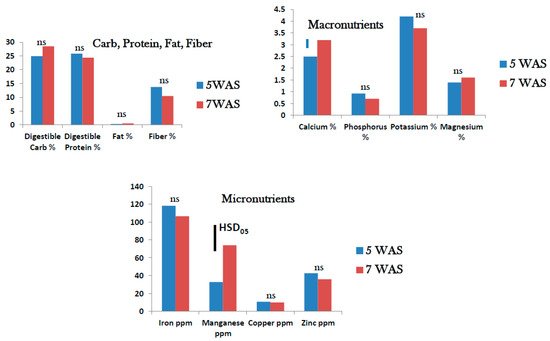
Figure 3. Field grown tropical spinach: Nutrient status 5 and 7 weeks after sowing (WAS) (ns = no significant difference; bars Tukey’s HSD at α = 0.05).
3.3. Roselle Micro/Baby-Green
As observed in tropical spinach micro/baby-green, proximate analysis showed that digestible carb and protein were present at high levels in roselle micro/baby-green. Digestible carbohydrates increased from 21–30% between 10 and 20 DAS while digestible protein decreased from 35–22% over the same period, Fat was low (<2.5%) and fiber was quite high and increased significantly from 13% at 10 DAS to 18.5% 20 DAS (Figure 4). Potassium at 3.75–4.20% was the predominant macronutrient in roselle micro/baby-green from 10–20 DAS. Phosphorus, Ca and Mg were present at low levels (<2%) from 10–20 DAS. No macronutrient showed significant difference in percent content from 10–20 DAS (Figure 4). Iron level at 220 ppm was highest in roselle micro/baby-green at 10 DAS. The level dropped rapidly to <100 ppm at 15 and 20 DAS. Manganese was high (148–180 ppm) in roselle micro/baby-green and unaffected by growth stage from 10–20 DAS. Copper was very low (<2 ppm) regardless of micro/baby-green growth stage, but Zn was high at 77–98 ppm and unaffected by the growth stage of the micro/baby-green roselle (Figure 4).

Figure 4. Roselle micro/baby-green: Nutrient status 10–20 days after seeding (DAS) (ns = no significant difference; bars show Tukey’s HSD at α = 0.05).
3.4. Mature (Field Grown) Roselle
Digestible carbohydrate at 36–38% and digestible protein at 18–22% were high in mature roselle foliage at 7 and 9 WAS and so was fiber at 14–17%, but fat was low (<2%). Proximate analysis showed no significant difference in nutritional content between 7 and 9 WAS (Figure 5). Macronutrients were generally low in mature roselle foliage at 7 and 9 WAS. Calcium at 1.6–2.0% and K at 1.3–1.7% were the highest macronutrients found in mature roselle foliage. Phosphorus and Mg were present at <1%. Calcium content in roselle foliage increased with plant age whereas K level decreased. Age of foliage did not affect P and Mg content in roselle (Figure 5). Among the micronutrients, Mn at 86–173 ppm was the most prominent in mature roselle foliage at 7 and 9 WAS followed by Fe at approximately 80 ppm. At 7 WAS, copper at 61 ppm was very high but dropped to 7 ppm at 9 WAS. Zinc content in roselle at approximately 20 ppm was similar at 7 and 9 WAS (Figure 5).

Figure 5. Field grown roselle: Nutrient status 7 and 9 weeks after sowing (WAS) (ns = no significant difference, bars show Tukey’s HSD at α = 0.05).
4. Tropical Spinach Micro/Baby-Green and Mature Plant
4.1. Carbohydrates, Protein, Fat, and Fiber
In tropical spinach, the micro/baby-green contained higher digestible protein (32.5%) than the marketable foliage from the field-grown crop (25%). Fat was also higher in the microgreen (2%) than in mature vegetable (<0.5%). However, the digestible carbohydrate was higher in the mature crop (27%) than in the microgreen (17.5%). The dietary fiber content (13%) was the same in the microgreen and mature plant (Figure 6).
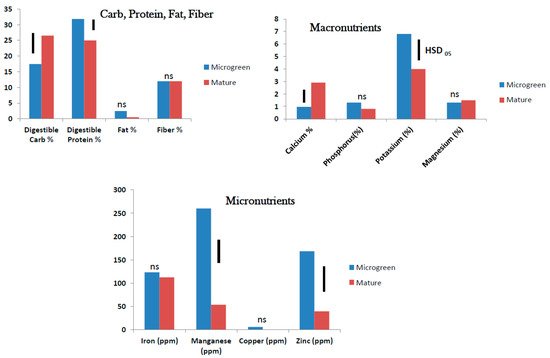
Figure 6. Nutrient status compared on dry weight basis between tropical spinach micro/baby-green (average of 10–20-day old seedlings) and mature plant (average of 5- and 7-week-old plants) (ns = no significant difference; bars show Tukey’s HSD at α = 0.05).
4.2. Macronutrients
Among the macronutrients, the microgreen contained higher level of potassium (K) (6.7%) than the marketable foliage of mature tropical spinach (4.1%), but Ca was higher in the mature plant (2.9%) than in the microgreen (0.9%). The levels of P (about 1%) and Mg (about 1.5%) were not affected by the growth stage of tropical spinach (Figure 6).
4.3. Micronutrients
Tropical spinach microgreen contained much higher levels of Mn (>260 ppm) and Zn (170 ppm) than the mature marketable foliage which contained <50 ppm Mn and <40 ppm Zn. Iron was reasonably high (about 120 ppm) in the micro/baby-green and mature tropical spinach but no statistical difference was observed between the two. Copper was very low (0.5–1 ppm) both in the microgreen and mature tropical spinach (Figure 6).
5. Roselle Micro/Baby-Green and Mature Plant
5.1. Carbohydrates, Protein, Fat, and Fiber
As observed in tropical spinach, digestible protein was higher in roselle microgreen (30%) than in the mature plant (22%). In addition, similar to tropical spinach, digestible carbohydrates were higher in the mature roselle (36%) than in the micro/baby-green (24%). The fiber content of roselle micro/baby-green and the mature foliage was close to 15% and no difference was observed in the two. The total fat content was low (1–2%) and no difference was observed between the micro/baby-green and the mature plant (Figure 7).
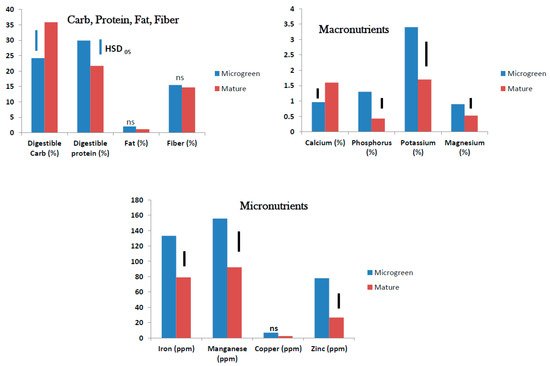
Figure 7. Nutrient status compared on dry weight basis between roselle micro/baby-green (average of 10–20 day-old seedlings) and mature plant (average of 7- and 9-week-old plants). (ns = no significant difference; bars show Tukey’s HSD at α = 0.05).
5.2. Macronutrients
All macronutrients except Ca were present at higher levels in the micro/baby-green than in mature roselle foliage. The most significant were P and K where the elements were two times higher (or more) in the micro/baby-green than in the mature foliage. As observed in tropical spinach, Ca was higher in the mature roselle (1.7%) than in the micro/baby-green (0.9%) (Figure 7).
5.3. Micronutrients
Manganese, Fe, and Zn were present in high amounts in roselle micro/baby-green and mature plant, but much higher in the micro/baby-green. Copper was relatively low in both the micro/baby-green and mature plant (1–4 ppm) (Figure 7).
6. Nutritional Value of Micro/Baby Green and Mature Field Grown Tropical Spinach and Roselle
Table 1 and Table 2 show the nutritional value of micro/baby green and mature field grown foliage of tropical spinach and roselle, respectively, for the macronutrients: carbohydrates, protein, and fat. For the tropical spinach, daily consumption of 100 g (dry weight basis) of the micro/baby green should meet 6.2% carbohydrate, 29.8% protein, and 3.2% fat daily intake value and the mature field grown foliage 9.8% carbohydrates, 22.2% protein, and 0.8% fat daily intake value. For roselle, daily consumption of 100 g (dry weight basis) of the micro/baby green should meet 8.7% carbohydrates, 26.7% protein, and 3.2% fat daily intake value and the mature field grown foliage 13.5% carbohydrates, 20% protein, and 1.6% fat daily intake value. In both plants, micro/baby greens are superior sources of protein compared to the mature field grown foliage. Consuming 100 g (dry weight basis) daily will meet close to 30% of the daily protein intake value. However, they are relatively poor sources of carbohydrates and fat and supply less than 10% of the daily intake values of these nutrients.
Table 1. Tropical spinach: nutritional value of 100 g (dry weight) micro/baby green and mature field grown foliage. Figures show average for 10-, 15-, and 20-day-old micro/baby greens and average for 5- and 7-week-old field grown plants. Daily value assumptions: Carbohydrates—1100 calories (Range 900–1300); Protein—450 calories (Range 200–700); Fat—550 calories (Range 400–700). Calorie estimation: 1 g Carbohydrates or Protein = 4 calories; 1 g Fat = 9 calories.
| Nutritional Item | Micro/Baby Green | % Daily Value | Field Grown Mature Foliage | % Daily Value |
|---|---|---|---|---|
| Digestible Carb (%) | 17 (68 calories/100 g) | 6.2 | 27 (108 calories/100 g) | 9.8 |
| Digestible Protein (%) | 33.5 (134 calories/100 g) | 29.8 | 25 (100 calories/100 g) | 22.2 |
| Total Fat (%) | 2 (18 calories/100 g) | 3.2 | 0.5 (4.5 calories/100 g) | 0.8 |
Table 2. Roselle: nutritional value of 100 g (dry weight) micro/baby green and mature field grown foliage. Figures show average for 10-, 15-, and 20-day-old micro/baby green and average for 7- and 9-week-old field grown plants. Daily value assumptions: Carbohydrates—1100 calories (Range 900–1300); Protein—450 calories (Range 200–700); Fat—550 calories (range 400–700). Calorie estimation: 1 g Carbohydrates or Protein = 4 calories; 1 g Fat = 9 calories.
| Nutritional Item | Micro/Baby Green | % Daily Value | Field Grown Mature Foliage | % Daily Value |
|---|---|---|---|---|
| Digestible Carb (%) | 24 (96 calories/100 g) | 8.7 | 37 (148 calories/100 g) | 13.5 |
| Digestible Protein (%) | 30 (120 calories/100 g) | 26.7 | 22.5 (90 calories/100 g) | 20 |
| Total Fat (%) | 2 (18 calories/100 g) | 3.2 | 1 (9 calories/100 g) | 1.6 |
References
- Treadwell, D.; Hochmuth, R.; Landrum, L.; Laughlin, W. Microgreens: A New Specialty Crop. EDIS 2020, 2020, 3.
- Samuolienė, G.; Brazaitytė, A.; Sirtautas, R.; Sakalauskienė, S.; Jankauskienė, J.; Duchovskis, P.; Novičkovas, A. The Impact of Supplementary Short-Term Red Led Lighting on The Antioxidant Properties of Microgreens. Acta Hortic. 2012, 649–656.
- Bliss, R.M. Specialty Greens Pack a Nutritional Punch. Agricultural Research Fact Sheet, USDA ARS Online Magazine; 2014. Available online: https://agresearchmag.ars.usda.gov/2014/jan/greens (accessed on 20 September 2021).
- Ebert, A.W.; Wu, T.H.; Yang, R.Y. Amaranth sprouts and microgreens—A homestead vegetable production option to enhance food and nutrition security in the rural-urban continuum. In Proceedings of the Symposium SEAVEG 2014: Families, Farms, Food—Sustaining Small-Scale Vegetable Production and Marketing Systems for Food and Nutrition Security, Bangkok, Thailand, 25–27 February 2014; pp. 233–244.
- Stoleru, T.; Ionita, A.A.; Zamfirachi, M.M. Microgreens—A new food product with great expectations. Rom. J. Plant Biol. 2016, 61, 7–16.
- Ghoora, M.D.; Srividya, N. Micro-farming of greens: A viable enterprise for enhancing economic, food and nutritional security of farmers. Int. J. Nutr. Agric. Res. 2018, 5, 10–16.
- Bunning, M. Sprouts vs. Microgreens: How Do the Risks Compare? Colorado State University, College of Health and Human Sciences. 2019. Available online: https://rmfoodsafety.org/wp-content/uploads/2019/06/RMFSC-2019_Bunning_.pdf (accessed on 23 March 2020).
- Lenzi, A.; Orlandini, A.; Bulgari, R.; Ferrante, A.; Bruschi, P. Antioxidant and mineral composition of three wild leafy species: A comparison between microgreens and babygreens. Foods 2019, 8, 487.
- Senevirathne, G.I.; Gama-Arachchige, N.S.; Karunaratne, A.M. Germination, harvesting stage, antioxidant activity and consumer acceptance of ten microgreens. Ceylon J. Sci. 2019, 48, 91–96.
- Verlinden, S. Microgreens: Definitions, product types and production practices. Hortic. Rev. 2020, 47, 85–124.
- Galieni, A.; Falcinelli, B.; Stagnari, F.; Datti, A.; Benincasa, P. Sprouts and Microgreens: Trends, Opportunities, and Horizons for Novel Research. Agronomy 2020, 10, 1424.
- Michell, K.A.; Isweiri, H.; Newman, S.E.; Bunning, M.; Bellows, L.L.; Dinges, M.M.; Grabos, L.E.; Rao, S.; Foster, M.T.; Heuberger, A.L.; et al. Microgreens: Consumer sensory perception and acceptance of an emerging functional food crop. J. Food Sci. 2020, 85, 926–935.
More
Information
Subjects:
Agriculture, Dairy & Animal Science
Contributor
MDPI registered users' name will be linked to their SciProfiles pages. To register with us, please refer to https://encyclopedia.pub/register
:
View Times:
1.2K
Revisions:
2 times
(View History)
Update Date:
28 Jan 2022
Notice
You are not a member of the advisory board for this topic. If you want to update advisory board member profile, please contact office@encyclopedia.pub.
OK
Confirm
Only members of the Encyclopedia advisory board for this topic are allowed to note entries. Would you like to become an advisory board member of the Encyclopedia?
Yes
No
${ textCharacter }/${ maxCharacter }
Submit
Cancel
Back
Comments
${ item }
|
More
No more~
There is no comment~
${ textCharacter }/${ maxCharacter }
Submit
Cancel
${ selectedItem.replyTextCharacter }/${ selectedItem.replyMaxCharacter }
Submit
Cancel
Confirm
Are you sure to Delete?
Yes
No




